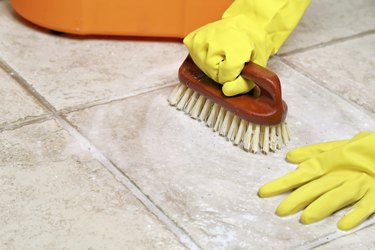
Bleach is any whitening agent, but the most common household bleach is a 5 percent solution of sodium hypochlorite. It is also a disinfecting agent that is used to clean contaminated equipment and for removing dangerous pathogens such as HIV, Ebola and tuberculosis from surfaces. The Occupational Safety and Health Administration (OSHA) sets the guidelines for companies that require workers to use bleach in the completion of their jobs.
Bleach Safety Data Sheet
Video of the Day
Employers are required to maintain a Safety Data Sheet for bleach and any other hazardous chemicals used in the workplace. These sheets spell out the risks associated with the chemical and how to safely handle them. Bleach is corrosive to skin and can cause irritation and even serious damage to the eyes. It is also corrosive when used on metals.
Video of the Day
Bleach PPE Requirements
OSHA lists the potential health problems that can occur from using cleaning chemicals with bleach in them while at work. The safety administration requires that workers wear personal protection equipment (PPE) such as goggles, gloves, masks and a covering for all exposed skin.
In settings such as hospitals, the biological material must be removed before the disinfection process begins, and that all disinfected surfaces be left wet for at least 10 minutes. Before use, all disinfected surfaces must be washed with water, dried and allowed to air out until no bleach remains.
Employer Responsibilities to Workers
Employers are responsible for knowing the requirements for their particular work environment for keeping employees healthy and safe from injury. They are responsible for ensuring worker protection by providing training and step-by-step procedures for use.
Employers must equip the employee or worker with the appropriate protective equipment equal to the task at hand. They must also advise employees to avoid mixing chemicals, such as ammonia and bleach, which create a harmful gas and provide correct labeling on chemical containers. Proper ventilation and cleanings stations must be provided to workers who use such chemicals.
OSHA Bleach Solution Ratio
When an employer requires the use of bleach for decontamination, OSHA recommends that workers include both a light solution for tools and small objects and a heavy solution for surfaces. The light solution can be soap and water, but if soap is not available, a light solution can be made with an OSHA bleach to water ratio of 1/4 cup of bleach to a gallon of water. Immerse objects to be cleaned for 10 minutes and allow to air dry.
Heavy Solution Cleaning
The OSHA recommended solution for disinfecting contaminated surfaces is to mix a heavy solution by adding 1 and 1/2 cups of bleach to a gallon of water. Under OSHA guidelines, these surfaces must be allowed to stand wet for three minutes and then wiped with a clean paper towel. Gloves and eye protection are recommended when using the heavy bleach decontamination solution.
Premixed heavy and light cleaning solutions must be kept in containers clearly labeled with contents and warnings. Both solutions should be prepared daily and allowed to stand for 30 minutes before use.